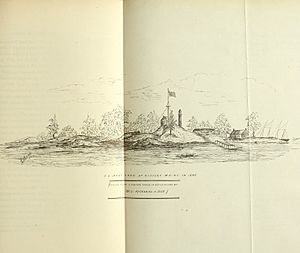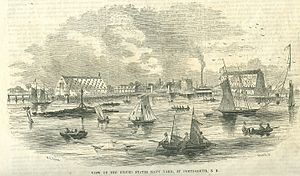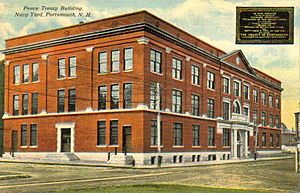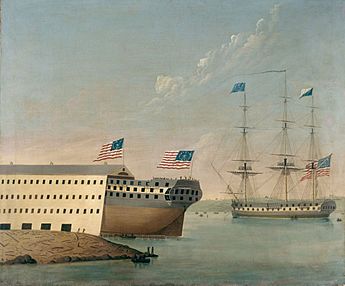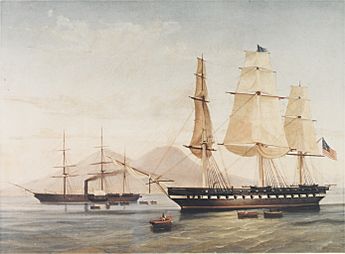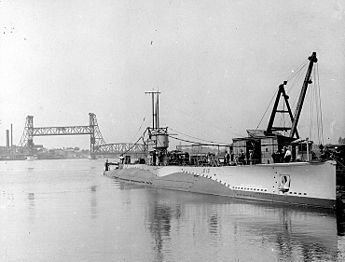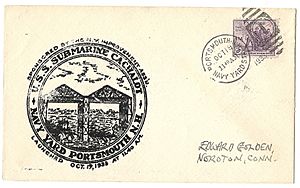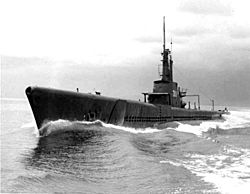Portsmouth Naval Shipyard facts for kids
Quick facts for kids Portsmouth Naval Shipyard |
|
|---|---|
| Seavey's Island, Kittery, Maine | |
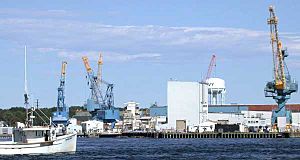
Portsmouth Naval Shipyard in 2004
|
|
| Coordinates | 43°4′44″N 70°44′3″W / 43.07889°N 70.73417°W |
| Type | Shipyard |
| Site information | |
| Controlled by | United States Navy |
| Open to the public |
No |
| Site history | |
| Built | 1800 |
| In use | 1800–Present |
| Battles/wars | |
|
Portsmouth Naval Shipyard
|
|
| Lua error in Module:Location_map at line 420: attempt to index field 'wikibase' (a nil value). | |
| Location | Seavey Island, Kittery, Maine |
| Area | 54 acres (22 ha) |
| Architectural style | Colonial Revival, Greek Revival |
| NRHP reference No. | 77000141 |
| Added to NRHP | November 17, 1977 |
| Garrison information | |
| Current commander |
Capt. Daniel Ettlich (August 2019-present) |
The Portsmouth Naval Shipyard, also known as the Portsmouth Navy Yard, is a United States Navy shipyard. It is located in Kittery, near the city of Portsmouth, New Hampshire. This shipyard is responsible for fixing, upgrading, and maintaining US Navy submarines.
Contents
History of the Shipyard
The Portsmouth Naval Shipyard started on June 12, 1800. This was during the time of President John Adams. It is the oldest shipyard of the U.S. Navy that has been working without stopping. The shipyard is on a group of connected islands called Seavey's Island. These islands are in the Piscataqua River. The river's strong currents keep ice from blocking ships from reaching the Atlantic Ocean.
This area has a long history of shipbuilding. Since colonial times, forests in New Hampshire and Maine provided wood for building boats. A British warship, HMS Falkland, was built here in 1696. It was the first British warship made in the Thirteen Colonies. The Royal Navy saved the tallest and straightest pine trees for ship masts. They marked these trees with a crown symbol.
During the American Revolution, the Raleigh was built in 1776. It was made on Badger's Island in Kittery. This ship was the first to fly an American flag into battle. The Raleigh has been on the Seal of New Hampshire since 1784. Other warships were built too, like Ranger. It launched in 1777 and was led by Captain John Paul Jones. This ship was the first U.S. Navy vessel to get an official salute from another country at sea. The 36-gun frigate Congress was also built here from 1795 to 1799. It was one of the first six frigates of the United States Navy.
In the 1790s, Secretary of the Navy Benjamin Stoddert decided to build the first federal shipyard. He chose Fernald's Island because it had skilled workers and lots of materials. The government paid $5,500 for the island. To protect the new shipyard, old Fort William and Mary was rebuilt and renamed Fort Constitution.
Commodore Isaac Hull was the first naval officer to lead the shipyard. He was in charge from 1800 to 1802, and again in 1812 during the War of 1812. The first ship built at the yard was the 74-gun Washington. It was launched in 1814. Buildings for soldiers were added in 1820, and for Marines in 1827. A hospital was built in 1834. In 1838, the huge Franklin Shiphouse was finished. It was 240 feet long and 131 feet wide. This building burned down on March 10, 1936. One of the most famous ships fixed here was Constitution, also known as "Old Ironsides," in 1855.
In 1898, captured soldiers from the Spanish–American War were held at the base. In 1905, work began on the Portsmouth Naval Prison. People called it "The Castle" because it looked like a castle. It was the main prison for the Navy and Marine Corps. It also held many German U-boat crews after they were captured. The prison closed in 1974.
Also in 1905, the Portsmouth Navy Yard hosted the Treaty of Portsmouth. This treaty ended the Russo-Japanese War. President Theodore Roosevelt won the 1906 Nobel Peace Prize for helping to arrange the peace conference. The meetings happened in the General Stores Building, which is now called the Administration Building (Building 86). In 2005, there were events to celebrate the 100th anniversary of the treaty. These included a Navy destroyer visit, a parade, and a re-enactment of the diplomats arriving.
During World War I, the shipyard started building submarines. L-8 was the first submarine ever built by a U.S. Navy yard. The base also kept fixing and repairing other ships. Because of this, the number of workers grew to almost 5,000. During World War II, it grew to nearly 25,000 workers. Over 70 submarines were built here, and once, four were launched in a single day!
After World War II, the shipyard became the Navy's main place for designing and developing submarines. In 1953, Albacore changed submarine design around the world. It had a special teardrop shape. Today, it is a museum in Portsmouth. Swordfish, the first nuclear-powered submarine built here, launched in 1957. The last submarine built at the shipyard was Sand Lance, launched in 1969. Today, the shipyard still works on submarines, refueling them and making them more modern.
In 1994, the shipyard was put on a list by the EPA for environmental cleanup. In 2005, there was a plan to close the shipyard by 2008. But employees started a "Save Our Shipyard" campaign. On August 24, 2005, the base was removed from the closure list. It continues to operate with its motto, "From Sails to Atoms."
The shipyard received the Meritorious Unit Commendation in 2005. This award recognized its excellent work from September 11, 2001, to August 30, 2004. During this time, the shipyard finished six major submarine projects early. It also saved money, reduced injuries by more than half, and met safety goals ahead of time.
Besides the Navy, the United States Army New England Recruiting Battalion moved to the shipyard in June 2010. The United States Coast Guard also uses the Portsmouth Navy Yard as a home port for some of its ships. These include Reliance, Tahoma, and Campbell.
Boundary Dispute
New Hampshire used to claim the Portsmouth Naval Shipyard belonged to them. But the U.S. Supreme Court ended the case in 2001. If it had been found to be in New Hampshire, employees from that state would not have to pay Maine income tax. Even after the court's decision, New Hampshire still said in 2006 that it owned Seavey's Island and the base.
Notable Ships Built at the Shipyard
- 1814 — Washington - (74-gun ship of the line)
- 1841 — Congress - (50-gun frigate)
- 1861 — Kearsarge - (steam sloop)
- 1864 — Franklin - (steam frigate)
- 1917 — L-8 - (first submarine built by a U.S. Navy yard)
- 1928 — Argonaut - (diesel submarine minelayer)
- 1929 — Narwhal - (diesel submarine cruiser)
- 1940 — Triton - (fleet submarine)
- 1941 — Drum - (fleet submarine)
- 1942 — Balao - (fleet submarine)
- 1943 — Archerfish - (fleet submarine)
- 1953 — Albacore - (experimental diesel submarine, changed submarine design)
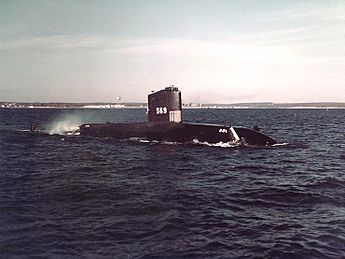
- 1958 — Swordfish - (first nuclear-powered submarine built here)
- 1960 — Thresher - (nuclear fast attack submarine)
- 1960 — Abraham Lincoln - (nuclear ballistic missile submarine)
- 1969 — Sand Lance - (last submarine built here)
Images for kids


